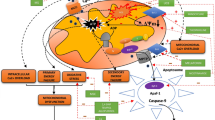Abstract
The asphyxial injury to neonate brain seems to be mediated through a cascade of biochemical events during ischaemia—reperfusion which includes excitatory amino acids, free radicals and accelerated programmed cell death (Apoptosis). The diagnosis of asphyxia requires rigorous approach based on background clinical information, certain diagnostic tests and exclusion of alternative diagnosis which may have similar clinical presentation. The treatment currently employed for the management of birth asphyxia controversial and requires critical appraisal. The future strategies for management include a number of approaches based on putative mechanism for asphyxial brain injury but they are still being evaluated as research and should not be used for clinical purposes in human newborns as yet.
Similar content being viewed by others
References
Committee on Obstetrics, Maternal and Fetal Medicine of the American College of Obstetrics: Utility of umbilical cord blood acid-based assessment.ACOG Committee Opinion, February 1991.
Bax M, Nelson KB. Birth Asphyxia: A Statement.Dev Med Child Neurol 1993; 35: 1023–1024.
Birth Asphyxia. MI Levene. In: David TJ, Ed.Recent Advances in Pediatrics No. 13. Churchill Livingstone 1995. pp. 13–27.
Lou HC. Hypoxic-haemodynamic pathogenesis of brain lesions in the newborn.Brain and Development 1994; 16: 423–431.
Predictors of neonatal encephalopathy in full term infants. Adamson SJ, Alessandri LM, Badawai N, Burton PR, Pemberton PJ, Stanley F.BMJ 1995; 2: 598–602.
Lou HC, Hansen D, Jensen F,et al. Prenatal maternal stress affects human fetal brain development. In: Lou H, Greisen G, Larsen F eds.Benzon Symposium No. 37 Brain lesions in the newborn. Copenhagen: Munksgaard, 1994: 247–252.
Marks KA, Edwards AD. Cerebral protection after hypoxia-ischaemia in newborn infants. In:Current Medical Literature— padiatrics. The Royal Society of Medicine. Vol. 7, No. 4, 1994.
D'Souza SWD. Excitatory amino acids in neonatal brain: Contributions to pathology and therapeutic strategies.Arch Dis Child 1995; 72: F147–150.
Saugstad OD. Neonatal oxygen radical disease. In: David TJ, Ed..Recent advances in padiatrics, Vol 10 Edinburgh: Churchill Livingstone, 1991; 173–187.
Raff MC, Barres BA, Burne JF, Coles HS, Ishizaki Y, Jacobson MD. Programmed cell death and the control of cell survival— lesson from the nervous system.Science 1993; 262: 695–700.
Proceedings of the 5th International Conference on Fetal and Neonatal Physiological Measurement. Keele University, Keele, Staffordshirdshire, UK, 2–5 September 1995.
Staub F, Mackert B, Kempski O, Peters J, Baethmann. A swelling and death of neuronal cells by lactic acid.J Neurol Sci 1993; 119: 79–84.
Reeves I, Mujsce D, Vannucci RC. Extreme hyperglycaemia protects the perinatal brain from hypoxic-ischaemic damage.Pediatr Res 1992; 31: 352 A.
Busto R, Globus My, Dietrich WD, Martinez E, Valdes I, Ginsberg MD. Effect of mild hypothermia on ischaemia-induced release of neurotransmitters and free fatty acids in rat brain.Stroke 1989; 20: 904–910.
Whitelaw A, Karlsson BR, Haaland K, Dahlin I, steen PA, Thoresen M. Hypocapnia and cerebral ischaemia in hypotensive newborn piglets.Arch Dis Child 1991; 66: F1110–1114.
Levene MI. Role of excitatory amino acid antagonists in the management of birth asphyxia.Biol Neonate 1992; 62: 248–251.
Randomised Asphyxia Study (RAST) Pilot phase 1995.Yorkshire Clinical Trials and Research Unit, Arthington House, Hospital Lane, Leeds, UK.
Palmer C, Towfighi J, Roberts RL. Heitjan DF. Allupurinol Administered After inducing Hypoxia-ischaemic reduces brain injury in 7-day-old rats.Pediatr Res 1993; 33: 405–411.
Dragunow M, Beilharz EJ, Mason B, Lawlor P, Abraham W, Gluckman PD. Brain-derived neurotrophic factor expression after long-term potentiation.Neurosci Lett 1993; 160: 232–236.
Author information
Authors and Affiliations
Rights and permissions
About this article
Cite this article
Sinha, S.K., Singh, J. Newer concepts and approaches to neonatal brain asphyxia. Indian J Pediatr 65, 55–62 (1998). https://doi.org/10.1007/BF02849695
Issue Date:
DOI: https://doi.org/10.1007/BF02849695




